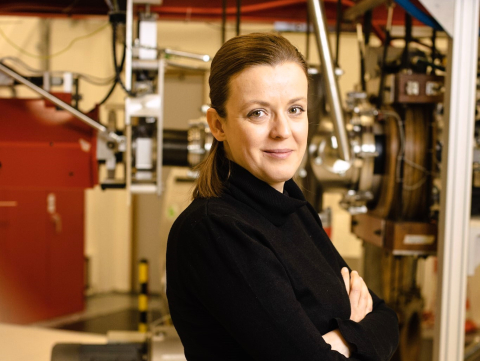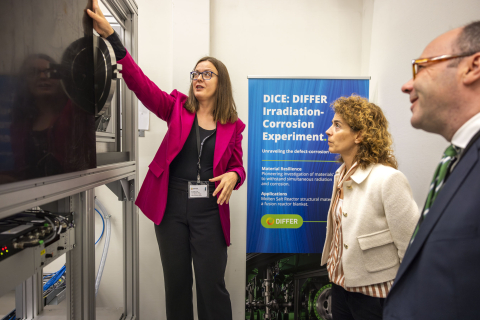Beata Tyburska-Pueschel sees a multitude of research opportunities lie ahead in the coming decades. The new group leader of the Radiation-Induced Defect Research group (RIDER) has ambitious plans for the future: “Now is the moment it is going to take off.”
Since she started at DIFFER five years ago, Tyburska-Pueschel has been the driving force behind significant developments at the institute. Starting with an Ion Beam Facility (IBF) that operated 500 hours per year for fewer than five users in 2019, to a facility that operates 3500 hours for about 20 users in 2025. We are talking about a facility that can be used for ion beam analysis and ion irradiation, which paves the way for in-depth studies of energy materials. It can accommodate eight beam lines, of which currently four are in use. The facility is coupled to Magnum-PSI, the world’s most powerful linear plasma source.

Tyburska-Pueschel: “When I came to DIFFER in 2019, we experienced various problems to solve, for instance with the beam. I didn’t want to leave any stone unturned, so to speak. So I decided to go one by one and repair everything. In three months, we solved the beam astigmatism.”
World unique facilities
It was the start of an exciting period, a lustrum in which UPP and DICE came to DIFFER. UPP combines the potentials of a high flux magnetized linear plasma generator with operando ion beam analysis to study the dynamic and steady-state plasma-material interaction during plasma exposure. With DICE (the DIFFER Irradiation Corrosion Experiment), researchers develop materials resistant to the combination of heat, salt and radiation.
Tyburska-Pueschel: “These are definitely world-unique facilities. Combined with Magnum-PSI you can perform absolutely unique measurements. We now have four types of experiments no one else has got, which attracts users. We are the only accelerator like that in the Netherlands, which also creates demand.” The PR and advertising efforts of Tyburska-Pueschel paid off well, as the Ion Beam Facility is fully booked.
What if you want to exceed the 2000 hours you can manage on working days? Scaling up operations during nights and weekends is one solution. To accomplish this without increasing your personnel, you need to automate so that the facility can run preplanned settings without constant supervision. Tyburska-Pueschel: “That automation presents a challenge for our software engineers, who are doing an outstanding job.This is also possible because we have the design office, mechanical workshop, and electrical engineering group in house.And then, of course, there are the research technicians. All of these steps combined is what drives future developments.”
A great example of this team effort is the opening of DICE in October 2023, when a delegation from the province of North-Brabant visited DIFFER for the inauguration. “I invited the technicians, and they were sitting in the same seminar room. They were asking questions and felt appreciated. In fact, I remember that I was sitting at the corner of the table, so they could talk to the deputy and external partners. Those are the people who did it. I have the ideas, but in fact, I didn’t touch a single screw”, Tyburska-Pueschel says.
Fifty-fifty
DIFFER’s new group leader will fulfill a 50-50 role and thus sees herself, in a positive sense, as a ‘test subject’. Besides the technical track (managing the Ion Beam Facility), there is the scientific one. “The scientific part was something I temporarily set aside when I came to DIFFER to focus on setting up the IBF. Now is the moment it is going to take off”, says Tyburska-Pueschel. For the research part, she is working for molten salt reactors. She is also teaching radiation damage in materials at TU Delft and wants to become a professor there. “There will be enough material to keep me engaged until I retire. New problems will arise, and new insights lead to new research questions.”

Besides automation, another solution for scaling up the IBF capacity, is to purchase a second accelerator, Tyburska-Pueschel explains: “Currently, I am using 20 percent of our Singletron accelerator’s time for the company Thorizon. I have users for the other beam lines as well, including group leaders from DIFFER. The problem with the accelerator is that it can only provide ions to one beam line at the time. If it goes here, than it doesn’t go there; you cannot split and do it simultaneously. Hence, my strong desire for an extra accelerator. That would also let us provide higher energy and different species of ions, and so on. What makes this challenging, is that they are not off-the-shelf and also costly.”
From automation to autonomy
A second wish of Tyburska-Pueschel is to develop an autonomous Ion Beam Facility. “We already have an automated facility, as it runs on preprogrammed settings by itself, all in a safe way. The next step is to go autonomous, where the system starts to make decisions on its own. That includes training of the system, with data analysis and interpretation. We want the machine to tell itself: this spot on the sample material is not good, let’s shift to another spot and repeat the measurement. It teaches itself what gives good quality measurements and what not. Scientists will need to train this system, so it will take some time. This is not going to happen in five years, we are talking about a decade.”
"Our users have gotten their first taste of what the IBF can do and now they want more", says Tyburska-Pueschel. “The machine has even taken steps outside of the world of fusion, conducting experiments for DIFFER's research on electrochemical water splitting. A second accelerator will provide us with more opportunities to be a user facility and thus, to accelerate the energy transition."
Author: Rianne van Hoek
Go to the News page.